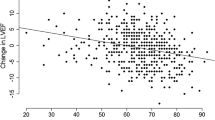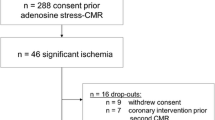Abstract
Background
We sought to evaluate the role of adenosine myocardial contrast echocardiography (MCE) for the determination of functional relevance of coronary stenoses with intermediate angiographic severity and compared the results to single photon imaging (SPECT). We hypothezised that sole assessment of myocardial blood volume changes during adenosine on MCE would indicate functional stensosis relevance when accompanied by increased myocardial oxygen consumption (MVO2).
Methods
Fifty-seven patients with ≥1 coronary stenosis underwent adenosine MCE (ultraharmonic imaging) and exercise SPECT. On MCE, myocardial blood volume was assessed and constant or increased myocardial opacification during adenosine coupled with increased MVO2 was defined as normal and decreased opacification as abnormal.
Results
Rate–pressure product significantly increased during adenosine in all patients due to reflex tachycardia following mild hypotension, indicative of increased MVO2. Concordance between MCE and SPECT for the detection of reversible myocardial perfusion defects was 89% (κ = 0.83). Comparison of regions between rest and during adenosine as opposed to comparison to remote regions of the same stage was important for accurate assessment because concordance betweenn MCE and SPECT was less on separate assessment at rest (73%, κ = 0.40) compared to stress (91%, κ = 0.81, P < 0.05) mainly due to territories scored normal on SPECT and abnormal on MCE.
Conclusions
Assessment of myocardial blood volume changes during adenosine using MCE can be used for the determination of the functional relevance of coronary stenoses of intermediate angiographic severity if MVO2 is increased during adenosine.


Similar content being viewed by others
References
Hachamovitch R, Berman DS, Shaw LJ et al (1998) Incremental prognostic value of myocardial perfusion single photon emission computed tomography for the prediction of cardiac death: differential stratification for risk of cardiac death and myocardial infarction [published erratum appears in Circulation (1998) 98(2):190]. Circulation 97:535–543
Vanzetto G, Ormezzano O, Fagret D, Comet M, Denis B, Machecourt J (1999) Long-term additive prognostic value of thallium-201 myocardial perfusion imaging over clinical and exercise stress test in low to intermediate risk patients: study in 1137 patients with 6-year follow-up. Circulation 100:1521–1527
Marcus ML, Skorton DJ, Johnson MR, Collins SM, Harrison DG, Kerber RE (1988) Visual estimates of percent diameter coronary stenosis: “a battered gold standard”. J Am Coll Cardiol 11:882–885
Topol EJ, Nissen SE (1995) Our preoccupation with coronary luminology. The dissociation between clinical and angiographic findings in ischemic heart disease [see comments]. Circulation 92:2333–2342
Heller LI, Cates C, Popma J, et al. (1997) Intracoronary Doppler assessment of moderate coronary artery disease: comparison with 201Tl imaging and coronary angiography. FACTS Study Group. Circulation 96:484–490
Vogel RA (1988) Assessing stenosis significance by coronary arteriography: are the best variables good enough? J Am Coll Cardiol 12:692–693
Ryan TJ, Bauman WB, Kennedy JW et al (1993) Guidelines for percutaneous transluminal coronary angioplasty. A report of the American Heart Association/American College of Cardiology Task Force on assessment of diagnostic and therapeutic cardiovascular procedures (Committee on Percutaneous Transluminal Coronary Angioplasty). Circulation 88:2987–3007
Uren NG, Melin JA, De Bruyne B, Wijns W, Baudhuin T, Camici PG (1994) Relation between myocardial blood flow and the severity of coronary-artery stenosis. N Engl J Med 330:1782–8
Jayaweera AR, Wei K, Coggins M, Bin JP, Goodman C, Kaul S (1999) Role of capillaries in determining CBF reserve: new insights using myocardial contrast echocardiography. Am J Physiol 277:H2363–H2372
Kaul S, Senior R, Dittrich H, Raval U, Khattar R, Lahiri A (1997) Detection of coronary artery disease with myocardial contrast echocardiography: comparison with 99m Tc-sestamibi single-photon emission computed tomography. Circulation 96:785–792
Heinle SK, Noblin J, Goree-Best P et al (2000) Assessment of myocardial perfusion by harmonic power Doppler imaging at rest and during adenosine stress: comparison with (99m) Tc-sestamibi SPECT imaging. Circulation 102:55–60
Kuersten B, Murthy TH, Li P et al. (2001) Ultraharmonic myocardial contrast imaging: in vivo experimental and clinical data from a novel technique. J Am Soc Echocardiogr 14:910–916
Wei K, Jayaweera AR, Firoozan S, Linka A, Skyba DM, Kaul S (1998) Quantification of myocardial blood flow with ultrasound-induced destruction of microbubbles administered as a constant venous infusion. Circulation 97:473–483
Cerqueira MD, Verani MS, Schwaiger M, Heo J, Iskandrian AS (1994) Safety profile of adenosine stress perfusion imaging: results from the Adenoscan Multicenter Trial Registry. J Am Coll Cardiol 23:384–389
Le E, Jing-Pin B, Coggins MP, Wei K, Kaul S (2002) Relation between myocardial oxygen consumption and myocardial blood volume: a study using myocardial contrast echocardiography. J Am Soc Echocardiogr 15:857–863
Fleiss R, Landis RJ, Koch GG (1977) The measurement of observer agreement for categorial data. Biometrics 33:159–174
Senior R, Lepper W, Pasquet A, Chung G, Hoffmann R, Vanoverschelde JL, Cerqueira M, Kaul S (2004) Myocardial perfusion assessment in patients with medium probability of coronary artery disease and no prior myocardial infarction: comparison of myocardial contrast echocardiography with 99m Tc single-photon emission computed tomography. Am Heart J 147(6):1100–5
Jayaweera AR, Edwards N, Glasheen WP, Villanueva FS, Abbot RD, Kaul S (1994) In-vivo myocardial kinetics of air-filled albumin microbubbles during myocardial contrast echocardiography: comparison with radiolabeled red blood cell. Circ Res 74:1157–1165
Wei K, Skyba DM, Firschke C, Jayaweera AR, Lindner JR, Kaul S (1997) Interactions between microbubbles and ultrasound: in vitro and in vivo observations. J Am Coll Cardiol 29:1081–1088
Porter TR, Xie F, Silver M, Kricsfeld D, Oleary E (2001) Real-time perfusion imaging with low mechanical index pulse inversion Doppler imaging. J Am Coll Cardiol 37:748–753
Korosoglou G, DaSilva K, Labadze N, Dubart A, Hansen A, Rosenberg M, Zehelein J, Kuecherer H (2004) Real-time myocardial contrast echocardiography for pharmacologic stress testing: is quantitative estimation of myocardial blood flow reserve necessary? J Am Soc Echocardiogr 17:1–9
Wei K, Ragosta M, Thorpe J, Coggins M, Moos S, Kaul S (2001) Noninvasive quantification of coronary blood flow reserve in humans using myocardial contrast echocardiography. Circulation 103:2560–2565
Crystal GJ, Downey HF, Bashour F (1981) Small vessel and total coronary blood volume during intracoronary adenosine. Am J Physiol 41:H194–H201
Bin J-P, Pelberg RA, Wei K, Le E, Goodman NC, Kaul S (2002) Dobutamine versus dipyridamole for inducing reversible perfusion defects in chronic multivessel coronary artery stenosis. J Am Coll Cardiol 40:167–174
Masugata H, Lafitte S, Peters B, Strachan GM, DeMaria AN (2001) Comparison of real-time and intermittent triggered myocardial contrast echocardiography for quantification of coronary stenosis severity and transmural perfusion gradient. Circulation 104:1550–1556
Andrássy P, Zielinska M, Busch R, Schömig A, Firschke C (2002) Correlation between myocardial blood volume and the amount of viable myocardium in the infarct zone after mechanical reperfusion of acute myocardial infarction. Heart 87:350–355
Acknowledgements
Dr. Andrássy was the recipient of a fellowship training grant from the German Cardiac Society. The work was supported by a clinical research grant from Technische Universität München (KKF 87/03). We are indebted to Kevin Wei, M.D. for thoughtful critique of the manuscript.
Author information
Authors and Affiliations
Corresponding author
Rights and permissions
About this article
Cite this article
Firschke, C., Andrássy, P., Linka, A.Z. et al. Adenosine myocardial contrast echo in intermediate severity coronary stenoses: a prospective two-center study. Int J Cardiovasc Imaging 23, 311–321 (2007). https://doi.org/10.1007/s10554-006-9157-9
Received:
Accepted:
Published:
Issue Date:
DOI: https://doi.org/10.1007/s10554-006-9157-9




